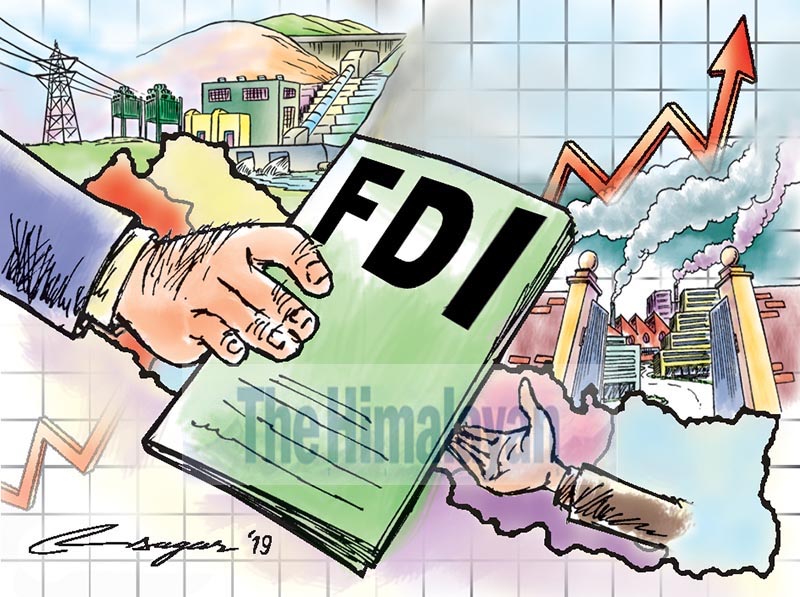Foreign direct investment: Improve investment climate
Prior to holding an investment summit, it is vital that the needs of investors and the projects they seek are explored than just calling on them to compromise and make do with the available policies and projects
A number of global reports have painted a gloomy picture of Nepal’s progress in improving the business climate to attract more inflows of foreign direct investment (FDI). For instance, among 190 economies, Nepal slid five places in the World Bank’s Doing Business index, which measures the ease with which business is conducted, to land at 110th position in 2018 from 105th position in 2017. It had attained an all-time high of 99 in 2016 and a record low of 123 in 2009 in the ranking. Likewise, according to UNCTAD’s World Investment Report 2019, Nepal obtained foreign direct investment equivalent to US$ 161 million in 2018 compared to $129 million in 2017. The country was ranked 6th in the South Asia region with a share of just 0.32 per cent.
Despite the meagre inflow of FDI into Nepal, it has been acknowledged that this financial inflow has the potential to bring in an array of benefits to the country. The advent of multinational corporations (MNCs) can promote efficiency through increased competition. It can also generate positive productivity spillovers as MNCs integrate domestic firms into their production processes through forward and backward linkages. Moreover, MNCs make new technology available and provide access to new markets, advancing the training and qualifications of the domestic labour force and raising wages and employment. The extent of these positive results, however, hinges on Nepal’s absorptive capacity.
Currently, foreign investors encounter difficulties pertaining to restrictions on foreign exchange, including regulations linked to off-shore funds, borrowing and capital repatriation. Overlapping administrative procedures and a lack of transparency in regulatory and administrative systems have also frustrated investors seeking to undertake projects in the country. A dearth of skilled labour force and technological expertise, inadequate physical infrastructure and exchange rate variability are just some of the reservations held by investors.
In order to encourage more quality FDI, the government recently introduced some Acts, including the Public-Private Partnership and Investment Act, 2019, the Foreign Investment and Technology Transfer Act (FITTA), 2019 and the Special Economic Zone Act (First Amendment). While the Public Private Partnership and Investment Act provides one-stop service for any foreign investment of more than Rs 6 billion or a hydropower project of over 200 MW capacity, the smooth and effective implementation of this Act requires that the government push for reforms to empower and improve the human resources of the bureaucracy and make them investment friendly.
Likewise, though FITTA ensures national treatment for any foreign investment and the incorporation of an automatic route system, which makes the FDI-related processes simple and predictable, ambiguities relating to the provisions in FITTA still exist. One of the contentious clauses concerns contract manufacturing operations by MNCs. FITTA specifies that the MNCs can hire other firms only to produce accessories and supporting goods, but not to produce finished goods. Currently, many foreign investment firms are hiring contract manufacturers to produce finished goods for them. This has given the MNCs a comparative advantage due to various factors, including cheap labour, which lowers the production cost. But with the implementation of FITTA, multinationals may not be able to engage other firms to produce finished goods, and this could be a setback for prospective investors.
Another ambiguity is with investment in the hydropower sector. While FITTA allows the Investment Board to issue production licenses for hydropower projects with a capacity above 200 MW, the Ministry of Energy will issue licenses for hydropower projects regardless of their production capacities as per the Electricity Act.
To date, Nepal has held three investment summits in the past, first in 1992, the second in 2017 and the third one in March 2019. Of the 77 projects that the government had showcased for investment in the 2019 summit, just 17 applications for 10 projects were filed. For these commitments to become a reality, however, the government needs to do regular follow-ups. Still, one lesson drawn from the summits is that prior to holding a summit, it is vital that the needs of investors and
the projects they seek are explored, as this would have a broader impact than just calling on investors to compromise and make do with the available policies and projects.
Presently, the investors are keeping a close watch on what steps the government will take in providing investment security and removing the administrative bottlenecks. They are also in a ‘wait and watch’ state with regard to implementation of the various provisions in the different bills.
To attract more FDI and make production competitive, it is important that the government brings down the cost of doing business since the production cost in Nepal is one of the highest in South Asia. And investors do look for profit opportunities. To conclude, the country needs to focus vigorously on creating a much more investment- friendly environment, which will facilitate higher and more sustainable GDP growth over the long term.
Pant writes on globalisation and trade issues






